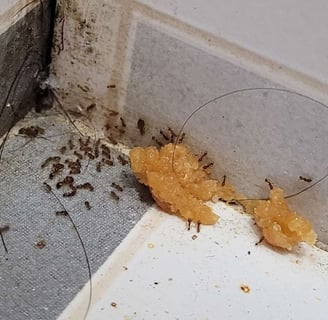Boric Acid for DIY Pest Control: All You Need to Know
Thinking of using boric acid for DIY pest control? Before you start, check out our guide to understand the pros and cons of using boric acid for pest control.
Chan, H.H.


Boric acid is often touted as a miracle solution for DIY pest control. While it can be effective in certain situations, it’s not the silver bullet many homeowners hope for. As pest control professionals, we’ve seen countless cases where DIY boric acid treatments fail to resolve infestations, leaving homeowners frustrated and dealing with recurring pest problems.
In this guide, we’ll explain how boric acid works, its limitations, and why professional pest control is often the better choice for long-term results.
What is Boric Acid, and How Does It Work?
Boric acid is a white, powdery substance derived from boron. It’s commonly used in DIY pest control because it’s relatively inexpensive and readily available. Here’s how it works:
Oral Ingestion: When insects consume boric acid, it disrupts their digestive system, leading to starvation and death within a few days.
Contact: Boric acid can also kill insects by damaging their exoskeletons, causing dehydration.
While boric acid can be effective against pests like ants and cockroaches, its success depends on several factors, including proper application, the right concentration, and the pests’ willingness to consume it.
The Challenges of Using Boric Acid for DIY Pest Control
While boric acid can be a useful tool, it’s not without its challenges. Here are some common issues homeowners face when using boric acid for DIY pest control:
Inconsistent Results
Pest Preferences: Ants and cockroaches have varying nutrient preferences. If the bait doesn’t match their current dietary needs, they’ll ignore it.
Concentration Issues: Too much boric acid makes the bait unpalatable, while too little renders it ineffective. Finding the right balance requires trial and error.
2. Freshness and Attractiveness
Bait Degradation: DIY baits are made by mixing the powder with food, such as sugar or peanut butter. Over time, the food can rot or dry out, losing its attractiveness to pests. This means you’ll need to frequently replace the bait to maintain its effectiveness.
No Long-Lasting Formulation: Unlike professional-grade baits, DIY boric acid sprays or dusts lack the formulations that ensure long-lasting effectiveness.
3. Safety Concerns
Inhalation Risk: Boric acid powder is fine and can easily become airborne, posing an inhalation hazard.
Toxicity: While generally safe in small amounts, boric acid can be harmful to humans and pets if ingested in large quantities. Children and pets are particularly vulnerable.
4. Time-Consuming Process
DIY boric acid treatments require patience and repeated applications. You will need to experiment different concentrations if you are trying to DIY baits. It can take weeks or even months to see results, and even then, there’s no guarantee the infestation will be fully eliminated.


When Boric Acid DIY Works (and When It Doesn’t)
Boric acid DIY can be effective in certain scenarios, such as:
Small, Localized Infestations: For minor ant trails or a few cockroaches, boric acid bait might help reduce the population.
Preventive Measures: Placing boric acid in areas where pests are likely to enter can act as a deterrent. There is a risk of inhaling the dust though.
However, boric acid is not suitable for:
Large or Widespread Infestations: DIY treatments often fail to address the root of the problem, allowing the infestation to persist.
Hidden Nests: If the nest is inaccessible, boric acid won’t reach the entire colony.
Non-Target Pests: Boric acid is ineffective against pests like termites, which require specialized treatments.
Contact Pest Sensei to Avoid the DIY Hassle
Dealing with pests can be time-consuming, frustrating, and often ineffective when done on your own. Why go through the hassle of trial-and-error DIY methods when you can leave it to the professionals?
At Pest Sensei, we specialize in effective, long-lasting pest control solutions tailored to your needs. Let us handle the problem so you can enjoy a pest-free home without the stress.
📞 Contact Us Today for a free consultation and non-obligatory quotation. Your peace of mind starts here!
Household Products with Boric Acid
Some household pest control products contain boric acid as an active ingredient. These products are formulated with the right concentration and additives to enhance their effectiveness. For example:
Pre-Made Baits: These are designed to be palatable to pests and often include attractants to lure them in.
Dusts and Powders: Some products use boric acid in a controlled formulation to minimize inhalation risks and improve application.
Pest Sensei
Expert pest control solutions for your needs in Johor Bahru and surrounding areas.
© 2025. All rights reserved.
Powered by Solbright
